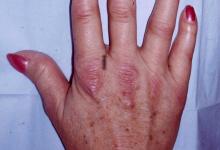Options for Refractory axSpA or PsA Save

Key Takeaways
- IL-17 inhibitors are approved for axial spondyloarthritis and psoriatic arthritis, but their effectiveness in heavily pretreated patients with active disease is not well known.
- This registry study examined one IL-17 inhibitor, ixekizumab, as used in patients with these conditions who had failed multiple targeted therapies.
- A quarter of patients with axial spondyloarthritis, and 43% of those with psoriatic arthritis, achieved low disease activity with ixekizumab, suggesting that it's a credible option.
Although most patients with axial spondyloarthritis (axSpA) or psoriatic arthritis (PsA) didn't respond adequately to the interleukin-17 (IL-17) inhibitor ixekizumab (Taltz), enough did that it should still be considered in such cases, a Danish registry study indicated.
In 709 patients with either of these conditions, 24% of axSpA cases and 43% of those with PsA achieved low disease activity 6 months after starting ixekizumab, according to Bente Glintborg, MD, PhD, DMSc, and colleagues at Rigshospitalet in Glostrup, Denmark. Importantly, well over half of patients in the study had failed two or more prior targeted therapies.
The drug made a dent even in some patients who had already failed an IL-17 inhibitor, the researchers reported in RMD Open. Median Axial Spondyloarthritis Disease Activity Score (ASDAS; low disease activity score <2.1) values for patients in the axSpA group dropped from 3.6 at baseline to 3.2 at month 6 -- the same 0.4-point decrease seen in patients who had not previously tried an IL-17 inhibitor (3.4 at baseline to 3.0 at month 6). Significant improvement was also seen in an analogous measure of PsA disease activity among patients with previous IL-17 inhibitor experience.
It was unfortunately the case that patients with prior unsuccessful anti-IL-17 treatment mostly didn't stick with ixekizumab. Two years after starting the drug, only about 30% of axSpA and PsA cases with IL-17 inhibitor experience were still on it.
Still, considering that axSpA and PsA patients who haven't responded to multiple targeted drugs don't have many good options, Glintborg's group argued that ixekizumab is probably worth a try. They pointed to the improvements seen in disease activity measures with the drug, even in patients for whom a previous anti-IL-17 product hadn't helped.
The researchers observed that while three IL-17 inhibitors are approved for axSpA and PsA -- ixekizumab, secukinumab (Cosentyx), and bimekizumab (Bimzelx) -- few data are available on their performance in heavily pretreated patients with these conditions who still don't have their disease under control. This is even more true for patients who have already tried and failed an IL-17 inhibitor.
In the current study -- examining patients enrolled in Denmark's DANBIO registry -- Glintborg and colleagues analyzed records of those who had initiated ixekizumab for axSpA or PsA (231 and 478, respectively). Half of the axSpA patients and nearly 40% of those with PsA had already attempted three or more targeted therapies. In these groups, 23% and 38%, respectively, were starting ixekizumab as their first or second targeted therapy.
For those with prior unsuccessful targeted therapy, tumor necrosis factor inhibitors were far and away the most common drug class attempted (96% of axSpA patients and 90% of those with PsA). Janus kinase (JAK) inhibitors were previously used by 18% and 14% of axSpA and PsA patients, respectively; about one-third of each group had previously used secukinumab without success.
Ixekizumab efficacy, in terms of disease activity, was evaluated at month 6 of treatment, while retention on the drug was assessed through 24 months.
Median ASDAS scores across all axSpA patients stood at 3.5 at treatment initiation and at 3.1 after 6 months. For PsA patients, the primary efficacy outcome was the DAPSA28 instrument (Disease Activity index for Psoriatic Arthritis with 28 joints assessed; low disease activity score ≤14); the median was 25.6 at baseline and 14.9 at month 6. In the PsA subgroup with previous secukinumab treatment, these values were 26.6 and 20.5, respectively, suggesting a lesser but still detectable treatment effect.
In both axSpA and PsA groups, about half of the patients with previous IL-17 inhibitor treatment had quit ixekizumab by month 9. In those without this prior experience, retention was much longer -- half the axSpA patients were still on the drug at month 22, and PsA dropouts never reached 50%.
As a registry study with real-world patients, the findings represent "important new evidence on [ixekizumab's] effectiveness in routine care," Glintborg and colleagues wrote. "To our knowledge, this is the first real-world study to explicitly report retention rates for ixekizumab in axSpA." As for PsA, ixekizumab retention has been examined in prior studies, and the current findings appear to be in reasonable agreement with them.
Limitations to the new study included the possibility of biases and unmeasured confounders; for PsA patients, no data on non-arthritic manifestations (skin and nail involvement, for example) that may have influenced treatment decisions were available. In fact, no information was available to indicate why previous therapies were discontinued.
Source Reference: Jensen KY, et al "Effectiveness of ixekizumab in 709 real-world patients with axial spondyloarthritis and psoriatic arthritis: a nationwide cohort study" RMD Open 2025; DOI: 10.1136/rmdopen-2025-005806.








If you are a health practitioner, you may Login/Register to comment.
Due to the nature of these comment forums, only health practitioners are allowed to comment at this time.